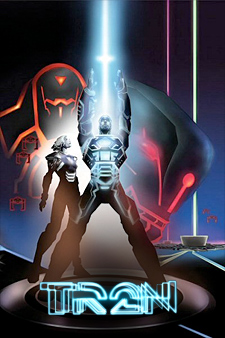
Script Review: Tron 2
Written by: Tony Lazlo, CC2K Staff Writer
Oh, my user, my user
Now, once we get past the opening scene in Tron 2, Jeffries quickly transports us to the cyber-world, where the script gains some momentum. Rush links up with some fellow programs and (as per his orders) takes on the seemingly nefarious Tron. Before I get into how Jeffries script short-shrifts the religious themes introduced in the original movie, let me provide a run-down of the characters in Tron 2 and what I thought of them.
Tron
Pretty much a cipher. He doesn’t have any dialogue, and Rush kills him about midway through the movie. His new look and new moves sound extremely badass, though, as seen in the original teaser trailer for this movie:
(Side note: Remember my fancypants “deep metaphor” interpretation of Lisberger’s cyber-world? Well, the role of light-cycles in these movies short-circuits it. I’m not sure how random programs can use the code from a video game for transportation, but despite that, I still like my interpretation. And also: Light-cycles are awesome.)
Oh, here’s one other cool thing about Tron: This is the only instance in this movie where we see a program that’s the result of more than one user — Flynn and Alan. That’s a missed opportunity in this movie. Back in the early 80s, single programmers writing entire programs from scratch was a little more common than today, when teams of developers will work on a single app. Just a thought.
Rush/Sean Flynn
Confused leading man and our proxy in the story. He eventually claims the Tron mantle.
Megan/Mega
The hot babe. I presume that Olivia Wilde is playing this role, and the thought of her in luminescent spandex sounds just fine.
Sinclair/Plexor
The bad guy. Indistinguishable from Dillinger/Sark in part one. Will John Hurt play this role?
Krod

A search program, and the movie’s comic relief. Pretty funny, with lots of off-kilter dialogue.
D-Rezz
A powerful deletion utility that helps out the heroes. Has the potential to be pretty cute. He growls menacingly at various bad guys while clobbering them and dies in a scene sure to distress the kiddies.
I-Beem
A frazzled denizen of the cyber-world. I’m not sure what kind of app he is, but he can teleport from one place to another.
Kevin Flynn
The hero of part one. In this movie, Flynn’s trapped deep inside the system and is the rougish leader of an army called the Finity Fighters. Jeffries portayal of Flynn isn’t bad, but as a leader, Flynn is stuck saying a lot of sis-boom-bah, inspirational speeches that feel strange coming out of his mouth.
Rumor held for years that Tron 2 would follow the structure of Joseph Conrad’s Heart of Darkness, and that we would discover a Flynn who had retreated deep inside the system and lost some part of himself. Jeffries’ script clearly includes an element of that idea, but it’s missing two things:
1. Flynn hasn’t lost his mind.
2. Flynn isn’t a god.
Fighting for the Users
Once again, I go back to Lisberger’s original movie, in which the MCP has shut down all Input/Output towers and made it illegal to believe in “users.” When Flynn first sees Tron, he asks:
“Who’s that?”
Another program answers: “That’s Tron. He fights for the users.”
Later in the movie, Tron infiltrates a defunct I/O tower. Here’s the scene — skip to timestamp 1:20:
I know this is obvious, but this is church for programs. Programs get to interact with their creators first-hand. Lisberger suffuses the entire scene with religious imagery and language. Note how Tron bows his head in prayer when the tower guardian says, “All that is visible must grow beyond itself, and extend into the realm of the invisible.”
Elsewhere in the original movie, Flynn — an actual user — hooks up with a friendly program called Ram, who eventually gets killed, and before he dies, he utters the (now infamous) line, “Oh, my user, my user.”
Jeffries script also includes a “users don’t exist” ban from the bad guys in charge, but he keeps his script completely secular — and that’s a shame. I’ve never read Heart of Darkness, but in Apocalypse Now, Kurtz has become a god among men deep in the jungle. By comparison, Flynn actually is a god in the cyber-world, and it’s too bad that Jeffries’ script doesn’t explore that very rich thematic territory.
Or maybe I just want to hear Flynn yell the battle cry, “Fight for the users!”
Other stuff
Like I said — I think this is a fairly early draft, and I hope that later rewrites have repaired the problems I laid down here, because if the teaser trailer is any indication, this has the potential to expand upon the wonderful world Lisberger introduced. It’s filled with great action sequences, and despite my earlier complaints, there’s still plenty of invention. To wit:
Apple Lisa
The code monkeys in the beginning have to break out an old Apple Lisa — one of Steve Jobs’ biggest boondoggles — to hack into the old mainframe. Awesome.
Flynn as an urban legend
Around Encom, it’s become the stuff of myth that Flynn actually went into the computer. Nice touch.
Hub City
We finally get a close look at a “city” in the cyber-world, where Encom’s operatives are running advertisements everywhere that X-Net is the latest and greatest thing.
Data surfing
While on the run, Rush, Krod, et al, have to surf along waves of data. Could go either way, but it’s a neat idea.
Memory leak
Memory leak, a pretty common problem for programmers, as I understand, is a deadly green sludge in the cyber-world. Cool.

